Apple iPhone 8 Plus vs Samsung Galaxy S8+
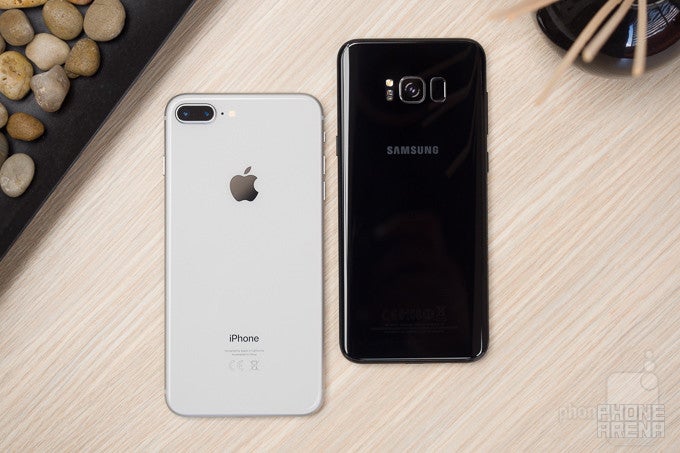
It’s only natural then to compare Apple’s newest iPhone 8 Plus against its rival, the Samsung Galaxy S8+. After all, both are big phones and both represent the finest from the two companies.
The S8+ is now cheaper as it’s been on the market for nearly half a year, but it’s not outdated by any means. It lacks the dual cameras of the iPhone, but matches it and outdoes it in other aspects. And while both are great phones, they are better at different things and we’re about to learn more about those differences right away.
Design
The iPhone 8 Plus feels like a slight update to an aging design, while the Galaxy looks sleeker, more modern.
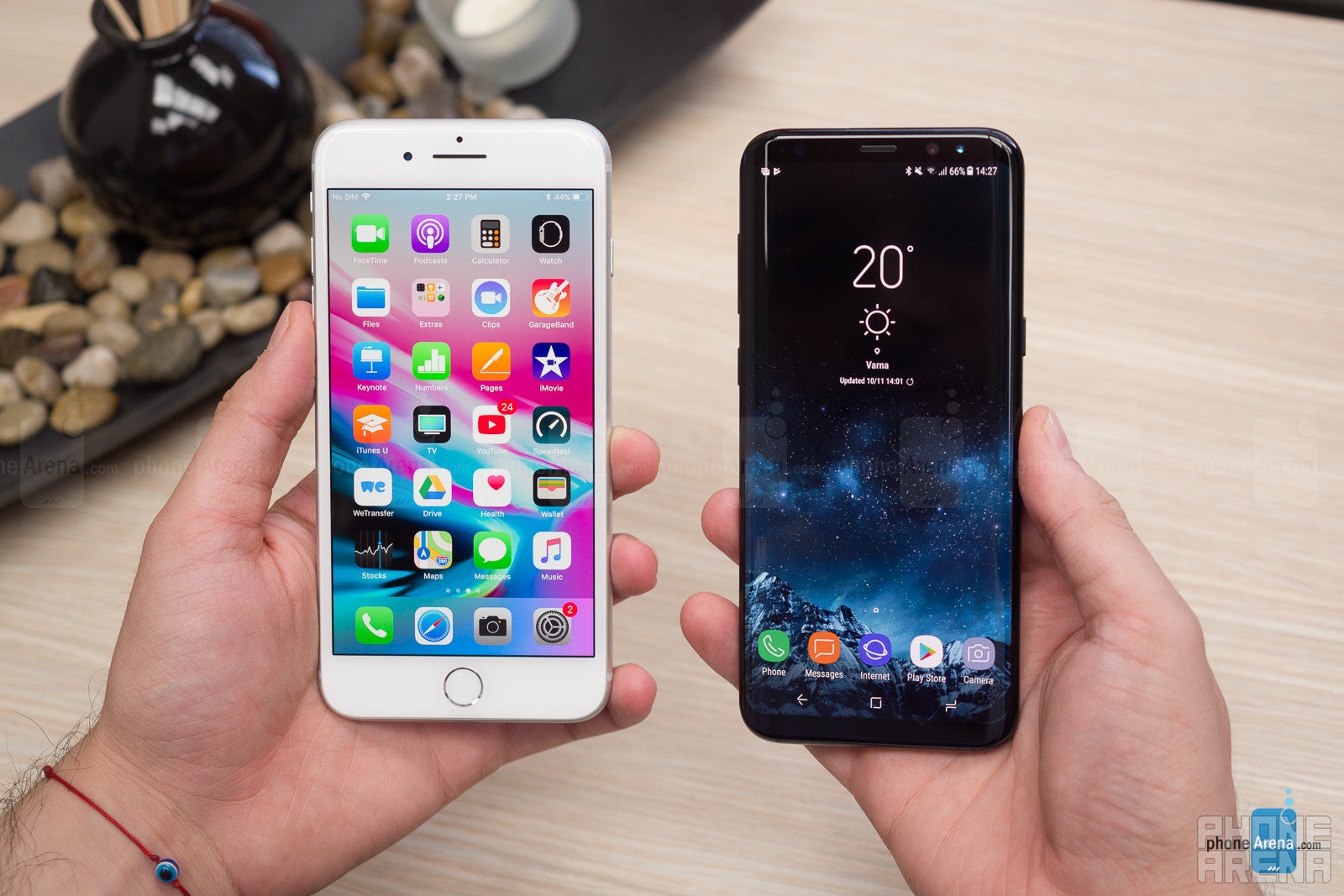
Samsung has leaped forward with beautiful, sleek, futuristic glass and metal concoctions, and the Galaxy S8+ is just that: one stylish phone with an immersive display. Apple, you ask? Well, it actually seems to be lagging behind these days: the iPhone 8 Plus has a glass back which adds style points, but the huge bezel up front remind us that we are still looking at the same four-year old design.
There are a few footnotes to all of this. First is color: the iPhone ships in three colors, but while they might sound familiar, the actual tones are different than on earlier iPhones. The silver one looks downright white and very clean, the gold one is a new shade of gold that is a mix between rose gold and the old gold, and both mask fingerprints extremely well. The space grey one actually has a brownish tone and is not even close to the deep hue of say last year’s jet black or even matte black options (it’s the only one where you can see fingerprint smudges easily). The S8+? It ships in four colors: black, blue, silver and gray, and finger smudges are very noticeable on all of those models.
In practical terms, the glass on both is not slippery, but can definitely shatter when you drop the phones, so a case is strongly recommended (yes, a case also admittedly ruins a lot of the design effort that went into those phones...).
The other important thing is to fully understand just how big these phones are. Neither phone fits comfortably in a jeans pocket, but the iPhone is especially uncomfortable. The S8+ is narrower, while the iPhone 8 Plus is very wide and you have to use both of your hands most of the times with these phones.
Here are the actual physical sizes of both:
- iPhone 8 Plus: 6.24 x 3.07 x 0.30 inches
- S8+: 6.28 x 2.89 x 0.32 inches
The iPhone weighs 7.13 ounces (202g) and is considerably heavier than the S8+ with its 6.10 oz (173g) of weight. We like a phone with a solid feeling in the hand, but if you are used to carrying your phone in your pants pockets, the extra weight of the iPhone adds to the inconvenience of having an already big phone, and can definitely be felt.
Considering they are so big, it is a bit annoying that Samsung continues to put the fingerprint scanner way out of reach and next the camera on the S8+. You get used to it, but it remains a daily inconvenience. In contrast, the front-placed iPhone 8 Plus finger scanner feels much more natural to use.
One last thing to know is that both phones are water-sealed (great news!): the iPhone carries an IP67 rating, while the S8+ has a higher, IP68 certification. What this means is that both are protected from dust ingress, and both can be submerged in water: the iPhone can withstand immersion in up to 3-feet deep water, while the IP68 S8+ can theoretically withstand up to 5-feet water depth, and both are guaranteed to survive in water for as long as 30 minutes.
Display
The S8+ has an immersive, bezel-less AMOLED display with punchy colors that pulls ahead. The iPhone has big bezels from the past, but colors also look great on it.

There are two things that make high-end phones stand out: one is the camera and the other is the display. And these two sure stand out, as they have two of the finest screens out there.
The S8+ sports a 6.3-inch Super AMOLED display, while the iPhone 8 Plus features a 5.5-inch LCD. Both default to 1080p resolution, but you can set a higher, Quad HD resolution on the S8+ (this will result in theoretically better sharpness, but will also negatively affect the battery life).
The big difference here, however, is in the form of the screen. Samsung calls its screen the “Infinity Display” because it feels like it flows into the body of the phone and has almost no bezels. The screen-to-body ratio of the S8+ is a whopping 83%, while on the iPhone it is merely 67.5% because of those big bezels on the top and the bottom. This sets the two apart in a big way: the S8+ feels more immersive and it fits more content.
But it’s not just size: it’s the lively colors that impress the most with these two. The S8+ has different color modes where you can tweak its appearance, but the default Adaptive mode shows punchy, saturated colors, with great contrast and deep blacks. The iPhone 8 Plus also has very pleasing colors, but they do not quite reach the lush tones you see on the S8+. Blacks appear slightly more grayish and contrast is a bit lower, but everything also looks a bit better balanced, even if slightly toned down.
Then, the iPhone 8 Plus comes with one neat innovation: True Tone technology. True Tone will adapt the display’s white balance to ambient light, usually making your phone look slightly warmer indoors, for a more natural look. We like this small convenience.
Interface
iOS 11 looks great and you know the iPhone will get updated for a long time. Android is easier to customize, though.

iOS on the iPhone and Android on the Samsung are two fundamentally different platforms that do mostly the same things, but in a different way.
On the iPhone 8 Plus, you get iOS 11, while the Galaxy S8+ ships with Android 7.1 with the Samsung Experience skin. And no, Android 7.1 is not the latest version of Android, that would be Oreo, and don’t ask us when you are going to get that (spoiler: it’s going to be months, not weeks of waiting).
Let’s ignore that, though, and look at what you get with both phones. The iPhone has got iMessage. The instant messaging service is used by a lot of people in the US (and not so much outside the US), but if you use iMessage, good news is that Apple is working hard to make the experience better and since it does not run on Android, it is one key feature that is keeping people in the Apple camp.
Then, the new iPhone does Augmented Reality with Apple’s ARKit. ARKit is a lot of fun: you can measure things accurately with just your phone, a new IKEA app allows you to see how furniture will look in your home before you buy it, you can explore the human body in AR and you have some neat games. Yes, not all of those features are super useful, but some are and it feels like Android is playing catch-up here.
The App Store is another key advantage: it has better apps and games of higher quality. iOS 11 is also visually refined: everything looks good with those semi-transparent backgrounds and fonts are properly scaled, while you have far less consistency with such details on Android.
Android on the S8+, however, beats the iPhone in customization options with themes and icon packs, things that you simply cannot change on the iPhone. You also have split-screen multitasking for power users. Plus, you get edge features: a tiny panel on the side that allows you to get shortcuts, your favorite contacts, weather and stock information right away from any place in the phone.
In addition, you can unlock your phone with just your eye-sight (you first have to register your eyes), and it works fine when the phone is not too far away from your face, but it’s nowhere near as instant and reliable as the fingerprint scanner.
There is another cool feature the S8+ supports: DeX. Place your S8+ on a tiny dock, connect it to a large-screen monitor and it will work as a desktop computer, allowing you to do work on the big screen. Others have done it (not so well), and while Samsung’s implementation is not perfect, it’s still good for doing text work, browsing or going through your photos or videos.
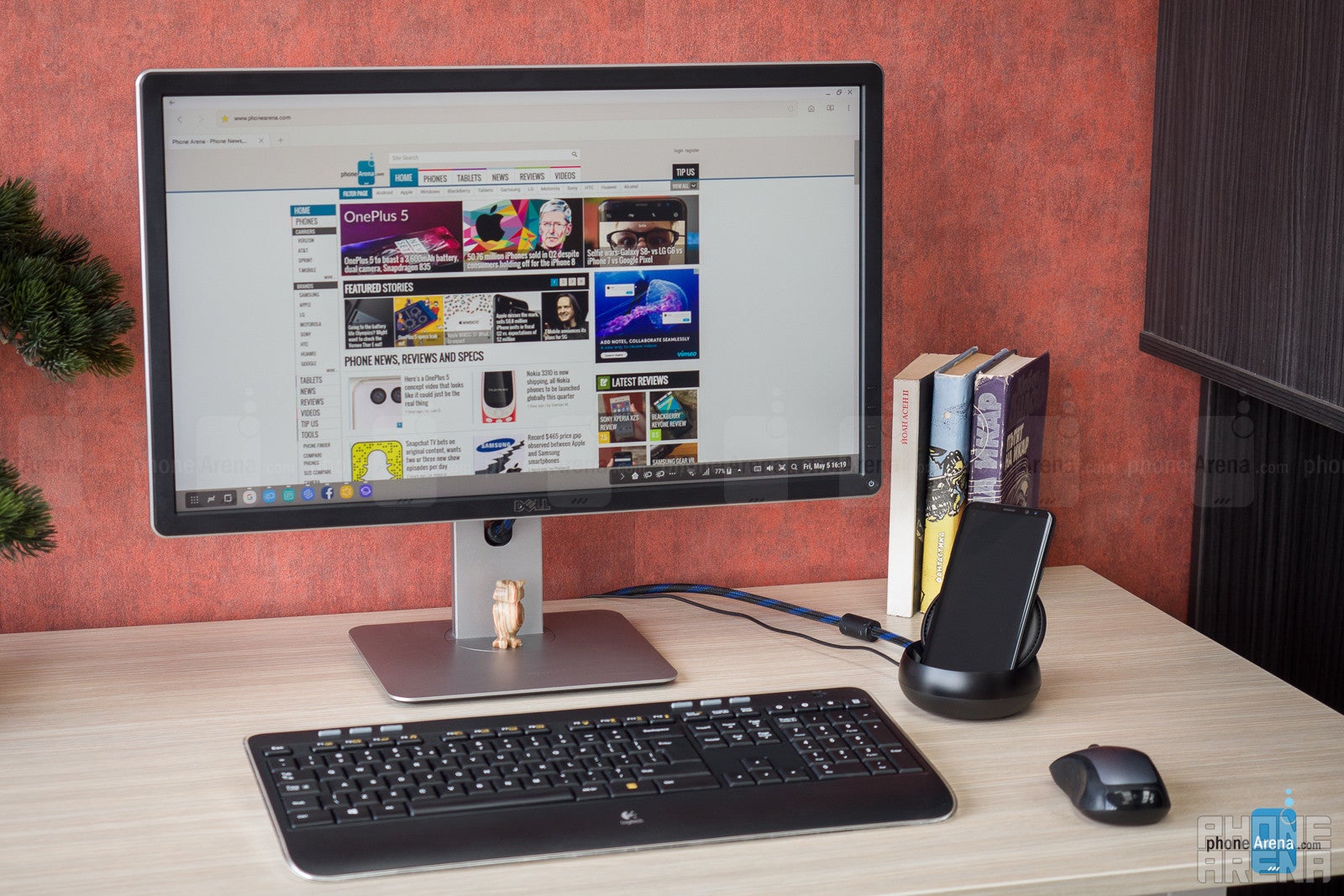
The DeX Station
Apple’s Siri vs Samsung Bixby vs Google Assistant
On the iPhone you have Apple’s Siri, while on the S8+ you get two voice helpers: Samsung’s new Bixby and the Google Assistant.
Siri has one key advantage over the others: you can use it straight from the lockscreen, without needing to unlock your phone to quickly set an alarm, add a reminder, a calendar event or what not, and this definitely gives it a speed advantage. And it works with the Apple Watch and AirPods.
Samsung’s Bixby is the newest voice assistant on the block and it is not yet compatible with wearables and other gadgets, but it has one super-power: it can do things inside apps that the other two cannot. But it requires very exact phrasing, it does not understand voices as well as the other two.
The Google Assistant understands what you say better than all others, knows context better and can just do a bit more and faster, so it’s our preferred choice at the moment.
Performance and Storage
The A11 chip beats the Snapdragon 835, but it’s Samsung’s own faults that make the S8+ feel more stuttery.
In 2017, all flagship Android phones come with the Snapdragon 835 chip, while Apple’s iPhone 8 Plus has pulled far ahead with its new Apple A11 Bionic chip.
The A11 Bionic is a hexa-core design with two big CPU cores and four smaller ones, while the Snapdragon 835 has octa-core design with four big and four smaller cores. There is also 3GB of RAM on the iPhone, 4GB RAM on the S8+. The A11 benchmarks blow all other mobile chips out of the water, including the Snapdragon 835, and you can see the numbers in our benchmarks below. The chip even matches some Intel Core i series chips in limited-time performance! It beats laptops like the MacBook Pro!
But those advancements can only truly be felt in very few apps: rendering video or editing photos, but not in the daily grind where the iPhone runs… well, like an iPhone, it’s hard to see much of a difference. The S8+ is also fast, but it’s far less smooth and stutters in some places, often shamefully so as in opening the app drawer, which sometimes happens with a noticeable stutter.
For gamers, the iPhone is the better phone than the S8+ by a long shot. Yes, it’s the performance, but more so just because is has more and better games that come to the App Store faster.
In terms of storage, the iPhone comes in two versions: 64GB and 256GB with no memory expansion option, while the S8+ has 64GB of native storage, but also the welcome microSD card for expandable storage.
Camera
The iPhone 8 has more appealing colors and better dynamics, but the Galaxy S8+ takes sharper pictures, so it’s a draw. The 4K60fps video gives the iPhone an advantage, though.

Camera is one area where these two differ and you can see the difference with your naked eye: the iPhone has two cameras on the back, while the Galaxy only has one. The secondary iPhone camera has a zoom lens and - as you well know - it enables Portrait Mode, a special feature that smartly blurs the background of a photo to make the subject stand out. This was previously only possible on a bigger camera with a bigger sensor.
First, though, let’s say that our experience with both cameras is great. Both open similarly quickly and snapping pictures is very fast on both.
First thing you notice when you compare photos from the two is the difference in colors. The iPhone 8 Plus brings a new color filter and pictures on it come out with really great colors: punchy, vibrant, with very proper white balance. The Galaxy S8+ also snaps similarly great photos: in most cases, pictures are not as vibrant, but are sharper, way sharper across the whole frame. So yes, they do capture different photos, but here is the thing: both look great in their differences and it’s a matter of personal preference which one you like better.
Portrait Mode
Portrait Mode is an effect that you can get via third-party apps on the Galaxy, but that’s not quite up to par with the dedicated iPhone portrait capabilities. Is Portrait mode a game-changer? Depends on who you ask. The facts are such: portrait mode photos are way smaller than usual iPhone photos, have far less detail, but come with that really cool look. Also, Portrait mode is made for portraits (duh!), and if you are trying to blur the background on a flower, it will not work so well. So yes, it’s a hit and miss, and there is a lot of room to improve, but if you like shooting portraits, chances are that you will miss this feature on the S8+.
What the S8+ does have is a “Selective Focus” mode that acts similarly to Portrait mode. It is slower to capture pictures in this mode and you have to hold your phone still because it actually captures multiple shots and combines them in a single image. You can then set the focus on the foreground and blur the background, much like portrait mode. It's not quite as accurate as on the iPhone, but it's something. And, you can also use it with the front camera, which is not an option on the iPhone 8 Plus.
The iPhone 8 Plus also has new Portrait Lighting effects that the S8+ does not. We don’t find this a huge loss. The effects feel a lot like filters from other apps. You have studio, contour, stage and stage mono lighting effects. The first one is subtle and we use it the most, the other three are very dramatic and have a very radical look that is a hit-or-miss. All are still in beta and it shows as sometimes the stage light would cut parts of the hair or a face of a person in a really bad way.
You can learn more about Portrait Lighting, in our detailed article here.
Video
One area where the iPhone has a clear advantage is video: it supports 4K at 60fps, which is… really impressive. The S8+ has 4K at 30fps, but it does not look anywhere nearly as good, and editing a 4K video on Android is practically impossible, while on the iPhone you can easily edit 4K 30fps video with the free iMovie (60fps is not supported yet, but we expect it will be in an update). Here’s a word of warning: 4K 60fps comes with double the storage size and drains battery like crazy, so if you plan to vlog a lot using that setting, you’d better spend $150 extra for that 256GB iPhone model.
Now, even if we compare 4K at 30fps on the two, we can see that the iPhone has better dynamic range (highlights are often burned on the Samsung), and it has better video stabilization (the Samsung has a funny jello effect from the OIS module).


Image formats and sizes
iPhone now uses modern HEIF and HEVC formats for photos and videos. What does that mean? These new formats can half the size of photos and videos. 1 minute of 4K 30fps video now takes up 170MB, while it used to require 350MB of space. But - and that’s important - the new formats are not widely recognized yet by many programs. Good news is that they automatically get converted to standard file formats when you share them. It takes a bit longer to share, but this ensures you won't have compatibility problems. The S8+ uses the standard JPEG and MP4 file formats that take up more space, but are easily recognizable across all platforms.

Sound
There is a single bottom firing loudspeaker on the S8+ and it is nothing special, just okay. Actually, in comparison with the iPhone 8 Plus, it is plain bad. That’s because the 8 Plus has amazing sound from its two speakers (one on the bottom and one hidden in the earpiece), far exceeding what you expect from a phone: it’s noticeably louder, noticeably clearer, crisper, better pronounced, it’s really something special.
Of course, using headphones results in much higher quality of the audio, but there is no audio jack on the iPhone 8 Plus. Yes, it’s been a year, and no, the Lightning ecosystem of headphones has not really gotten much bigger. You do have the cool AirPods and while we do recommend them, they cost $160 and we miss having more options. Dealing with the unsightly Lighting to 3.5mm adapter is really not something that we are looking forward to either, but you should know that the adapter does come included in the box. It’s all much easier on the S8+ where the good old jack is present.
Battery Life
You’d still need to charge them every night, but the iPhone 8 battery goes a little longer.
Fancy screens, dual cameras and… one day battery life. It seems like battery life just does not improve at the same pace as other aspects of phones. But it does move forward slightly: the iPhone 8 Plus and the Galaxy S8+ feature slightly better longevity than their predecessors, and both will last a full day on a singlе charge for most people.

In terms of battery capacity, there is a 2,675mAh battery on the iPhone 8 Plus and a 3,500mAh cell on the S8+. And just looking at those numbers is a reminder not to judge a phone’s battery life solely by the mAh capacity of a cell.
There is another important aspect of battery life and that is the time it takes to recharge a battery. Say hallelujah and welcome fast charging on the iPhone 8 Plus, a feature that other phones - including Samsungs - have had for years, yet Apple adopts only now. Better late than never. But in order to actually use fast-charging on the iPhone, you can’t simply use the charger that’s in the box with your new iPhone. That only supports regular charging speeds. For fast charge you need to buy an additional adapter: the 29-watt USB-C Apple Power Adapter, sold for $50 in Apple Stores and bulkier than most other fast chargers. That’s a rip-off. If you do get that larger and more powerful charger, though, you will get around 40% charge from zero in just thirty minutes, on par with Samsung.
Also, the iPhone now finally supports Qi wireless charging, another feature present on many top Android phones (including Samsung’s) in the past years. The iPhone, however, only supports the slower, 7.5-watt wireless chargers and not the more convenient 15-watt ones like the Galaxy S8+ supports.
Call Quality
We’ve had no issues with call quality on the particular iPhone 8 Plus and S8 Plus models we tested for this review. Some early users reported hearing a lot of static noise on iPhones (our other iPhone review did indeed suffer from such problems), but luckily, Apple has already issued a software update that fixes those issues.
Conclusion
So… which one should you get?
Let’s first look at the prices:
- iPhone 8 Plus 64GB / 256GB: $800 / $950
- Galaxy S8+ 64GB: sold for $725 at the time of this writing (original price is $825)
As you can see, the price difference is there and the new iPhone 8 Plus is costlier than the Galaxy S8+.
As we said in the beginning, both also have very distinct strengths: for the Galaxy S8+ that is the immersive bezel-less screen with eye-popping colors, the more modern design, Android with its better notifications, customizations and open nature, as well as support for little conveniences like the headphone jack.
The iPhone 8 Plus has other strong points: it is the faster phone with a buttery smooth performance that the Galaxy cannot match, it has that dual camera with Portrait mode which is a gimmick, but a fun one, it is also the more versatile device for creatives, it is the go-to phone for gamers, and last but not least, it will certainly get updates faster and be supported for way longer than the Samsung Galaxy phone.
The iPhone list of advantages is a bit longer, but can you deal with that four-year old design and its limitations? Answer that question, and you’ll know which of these two to get.
Apple iPhone 8 Plus
Pros
- 4K video at 60fps is impressive
- iOS, App Store, iMessage
- Guaranteed timely software updates
- Excellent battery life
- Outstanding loudspeaker quality
Samsung Galaxy S8+
Pros
- Futuristic design that's easier to hold
- More exciting color options
- Immersive, 18:9 display
- Great low-light camera
- Headphone jack
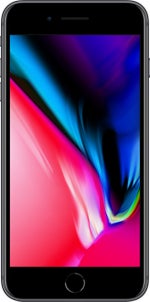
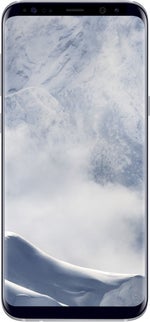



























Things that are NOT allowed: